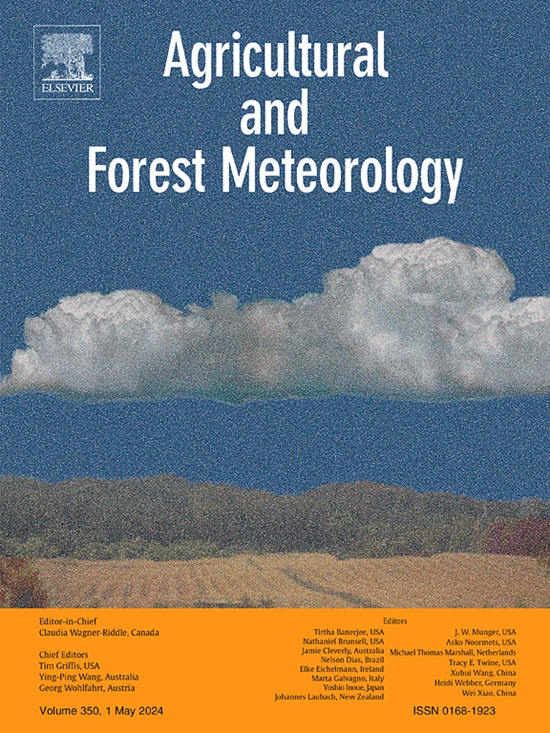多年生饲料作物混交种SIF、ANPP和RUE动态关系的解读
IF 5.6
1区 农林科学
Q1 AGRONOMY
引用次数: 0
摘要
航空净初级生产量的遥感估算是精准农业和环境监测领域面临的关键挑战。蒙蒂思模型是牧场的主要概念框架。太阳诱导荧光(SIF)与光合作用密切相关,当辐射利用效率(RUE)发生生理变化时,它是估计ANPP的一个有希望的候选物。我们的目的是分析SIF在不同结构和生理特征的牧草覆盖上估计ANPP和RUE的能力。此外,我们的目标是确定驱动这些相关性的潜在机制。我们通过在不同季节测量不同牧草覆盖(苜蓿、高羊茅和混合牧草),进行了近端感知实验。紫花苜蓿草地和混合地在APAR变化的情况下显示出相当恒定的RUE和荧光发射效率(SIFYield)。这使得SIF成为一个有趣的ANPP监测指标(R2 ~ 0.5),因为它们与APAR有很强的联系。另一方面,高羊茅的RUE随APAR的增加而降低,这减弱了ANPP-APAR的相关性(R2 ~ 0.38)。此外,逃逸分数的降低削弱了SIF-APAR相关性(R2 ~ 0.09)。因此,ANPP-SIF相关性消失(R2 ~ 0.02)。这是第一批遥感研究之一,分析了根据饲料农艺标准管理的田地中可供收获的生物量。我们的研究结果支持使用SIF作为饲料作物ANPP的监测,当RUE和SIF产量在APAR变化时可以假设是恒定的。然而,不同作物之间的相关性可能无法推断;必须仔细注意RUE在APAR上的变化。本文章由计算机程序翻译,如有差异,请以英文原文为准。
Deciphering the link between SIF, ANPP and RUE dynamics in perennial forage crop mixtures
Remote sensing estimation of aerial net primary production (ANPP) is a key challenge in precision agriculture and environmental monitoring. The Monteith model serves as the main conceptual frameworkin pastures.Sun-induced fluorescence (SIF), closely linked to photosynthesis, is a promising candidate for ANPP estimations when radiation use efficiency (RUE) undergoes physiological changes.
Our aim was to analyze SIF´s ability to estimate ANPP and RUE in forage covers with different structural and physiological characteristics. Moreover, we aimed to determine the underlying mechanisms driving these correlations. We performed a proximal sensing experiment by generating differential forage covers (alfalfa, tall fescue, and mixtures), measured across different seasons.
Alfalfa and mixture plots have shown fairly constant RUE and fluorescence emission efficiency (SIFYield) upon APAR variations. This caused SIF to be an interesting monitor of ANPP (R2 ∼ 0.5), because of their strong link with APAR. On the other hand, tall fescue showed decreasing RUE when increasing APAR, which weakens ANPP-APAR correlation (R2 ∼ 0.38). Also, reduced escape fraction weakens SIF-APAR correlation (R2 ∼ 0.09). Consequently, the ANPP-SIF correlation disappears (R2 ∼ 0.02).
This is one of the first remote sensing studies analyzing the biomass available for harvest in a field managed according to forage agronomic criteria. Our findings support the use of SIF as a monitor of ANPP of forage crops when RUE and SIF Yield can be assumed to be constant upon APAR variations. Nevertheless, correlations may not be extrapolated between different crops; careful attention must be paid to RUE variations upon APAR.
求助全文
通过发布文献求助,成功后即可免费获取论文全文。
去求助
来源期刊
CiteScore
10.30
自引率
9.70%
发文量
415
审稿时长
69 days
期刊介绍:
Agricultural and Forest Meteorology is an international journal for the publication of original articles and reviews on the inter-relationship between meteorology, agriculture, forestry, and natural ecosystems. Emphasis is on basic and applied scientific research relevant to practical problems in the field of plant and soil sciences, ecology and biogeochemistry as affected by weather as well as climate variability and change. Theoretical models should be tested against experimental data. Articles must appeal to an international audience. Special issues devoted to single topics are also published.
Typical topics include canopy micrometeorology (e.g. canopy radiation transfer, turbulence near the ground, evapotranspiration, energy balance, fluxes of trace gases), micrometeorological instrumentation (e.g., sensors for trace gases, flux measurement instruments, radiation measurement techniques), aerobiology (e.g. the dispersion of pollen, spores, insects and pesticides), biometeorology (e.g. the effect of weather and climate on plant distribution, crop yield, water-use efficiency, and plant phenology), forest-fire/weather interactions, and feedbacks from vegetation to weather and the climate system.

 求助内容:
求助内容: 应助结果提醒方式:
应助结果提醒方式:


